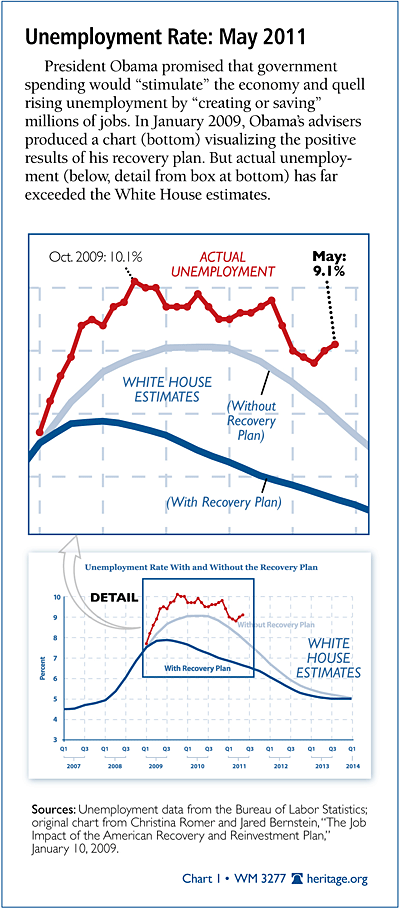The Bureau of Labor Statistics’ (BLS) employment report for the month of May is depressing. The unemployment rate climbed to 9.1 percent as the economy created only 54,000 new jobs. Even worse, the details of the employment report reveal a labor market that is stalling with few glimmers of optimism.
The Obama Administration’s economic policy has been a total failure with its complete disregard for businesses and job creation in the private sector. The Administration’s reliance on government spending and government experts to manage the economy has resulted in a labor market that is not recovering and a national debt that is at a crisis point. Congress needs to unshackle entrepreneurs and businesses from the stifling regulations and burdens that have been created in the past two years.
The May Report
The unemployment rate increased from 9.0 percent to 9.1 percent in May. Job growth is not keeping pace with the number of workers entering the labor force each month. The labor force participation rate remained flat at 64.2 percent, an all-time low for the fifth straight month.

The state of long-term unemployed workers is grim as the majority of unemployed workers have been unemployed for over five months. The average length of unemployment is now 39.7 weeks, the longest since the Department of Labor began tracking it. Almost half of all unemployed workers have been unemployed for longer than 27 weeks. Very few of these workers are finding work at the moment.
Private-sector hiring is anemic for an economic recovery: Some 83,000 net private-sector jobs were created, but the details are worrying. First, temporary service hiring (–1,200) was negative in the month of May, indicating slackening demand for labor. Second, the number of hours worked was flat again, indicating little strength in the labor market. The payroll survey was also revised downward by 39,000 jobs for the past two months. All three of these indicators show that there is little hope for a fast labor market recovery this summer.
Both employment surveys are converging and showing a labor market that has retreated over the past quarter. In the first quarter of 2011, private job creation exceeded 200,000 a month. Now the labor market is struggling to reach 100,000. Other macroeconomic indicators are slackening as GDP was also revised downward.
Businesses Not Hiring
Business hiring remains weak, and this is keeping unemployment high. Other data released by the BLS demonstrate this clearly. New hiring fell sharply at the recession’s onset and has not recovered. Job creation is still in deeply recessionary levels.
The BLS reported small job gains this month because layoffs, which rose at the start of the recession, have now fallen to below their pre-recession levels. Employers are letting fewer workers go. That is good news, but unemployment will not come down until business hiring picks up.
Administration v. Employers
Government policies are partially to blame for the weak business climate. Since taking office, the Obama Administration has pursued an ideological agenda of expanding the size and scope of the federal government. Many of these policies discourage businesses from expanding:
- The President responded to the recession with the stimulus, which massively expanded the size of government. President Obama now fiercely resists attempts to reduce spending and insists on dealing with the deficit by raising taxes on “the rich”—i.e., successful entrepreneurs and business owners. Increased government spending displaces private-sector business investment.[1]
- Subsequently, the President pressed his health care bill through Congress despite widespread popular resistance. Many features of Obamacare make hiring new workers significantly more expensive.[2] However, businesses do not know exactly how expensive health care will become. Consequently, many entrepreneurs have decided to wait and see how much Obamacare raises their costs before adding to their payrolls. Dennis Lockhart, president of the Atlanta Federal Reserve, reports that “We’ve frequently heard strong comments to the effect of ‘my company won’t hire a single additional worker until we know what health insurance costs are going to be.’”[3]
- Unionized employers create fewer jobs.[4] Nonetheless the Obama Administration is attempting to foist them on employers and employees. President Obama’s appointees to the National Labor Relations Board sued Boeing for creating jobs in South Carolina (a right-to-work state) and are poised to force companies to negotiate with multiple “micro-unions” representing small parts of their workforces.
- Pending trade agreements with South Korea, Colombia, and Panama would create new business opportunities and tens of thousands of jobs. The President has refused to submit these agreements until Congress renews the stimulus-enhanced version of the Trade Adjustment Assistance program.
- Rising energy costs have taken a bite out of American’s incomes, but the President opposes efforts to increase domestic energy production.
The Obama Administration has prioritized its ideological goals above economic growth. This policy choice discourages businesses and entrepreneurs from hiring.
Let Small Business Lead the Way
Small businesses often help lead the labor market out of an economic downturn. Yet small business hiring and creation has been anemic in the current recovery. This is one of the main reasons that the labor market recovery has been so weak given the magnitude of the economic downturn.
Unfortunately, policies from Washington have done more harm than good over the past two years. While the credit crunch had an impact on businesses, increased regulations and uncertainty about taxes and rules have delayed business expansion and hiring. Businesses, especially small businesses, have a hard time understanding how a certain regulation could affect their future business. This uncertainty means that businesses are less inclined to expand and add to their labor force. Policymakers should end the uncertainty by extending the 2001 and 2003 tax savings, addressing the long-term entitlement issues, and rolling back some of the regulations that have discouraged business formation and hiring.
Rea S. Hederman, Jr. , is Assistant Director of and Research Fellow in the Center for Data Analysis, and James Sherk is Senior Policy Analyst in Labor Economics, at The Heritage Foundation.



